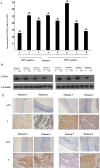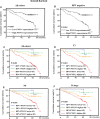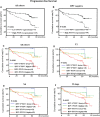Prostate tumor overexpressed-1, in conjunction with human papillomavirus status, predicts outcome in early-stage human laryngeal squamous cell carcinoma
- PMID: 26992242
- PMCID: PMC5077983
- DOI: 10.18632/oncotarget.8103
Prostate tumor overexpressed-1, in conjunction with human papillomavirus status, predicts outcome in early-stage human laryngeal squamous cell carcinoma
Abstract
In human cancer, molecular markers combined with clinical characteristics are used increasingly to predict prognosis. Prostate tumor overexpressed-1 (PTOV1), first identified in prostate cancer, is a key factor in tumor progression and correlates with unfavorable clinical outcomes. HPV infection status was tested by HPV E6-targeted multiplex real-time PCR and p16 immunohistochemistry (IHC). Real-time PCR and western blotting analyses were used to examine the mRNA and protein expression levels of PTOV1 in eight paired LSCC samples. IHC was performed to assess PTOV1 protein expression in 196 paraffin-embedded, archived LSCC samples. PTOV1 protein and mRNA expression was increased in LSCC tissues compared with adjacent non-cancerous tissue samples. High expression of PTOV1was significantly associated with advanced TNM stage by the χ2 test. Multivariate analysis revealed that PTOV1 and HPV status were independent prognostic indicators of overall survival (OS) and progression-free survival (PFS) (P = 0.001, P = 0.009 for OS, P = 0.005, P = 0.012 for PFS, respectively). Our study provides the first evidence that the combination of PTOV1 expression level and HPV status provides more prognostic information compared with HPV status alone with the significance still exists in the HPV negative subgroup.
Keywords: HPV; biomarker; laryngeal squamous cell carcinoma; prognosis; prostate tumor overexpressed-1.
Conflict of interest statement
All the authors declare that they have no conflicts of interest.
Figures





References
-
- Torre LA, Bray F, Siegel RL, Ferlay J, Lortet-Tieulent J, Jemal A. Global cancer statistics, 2012. CA: a cancer journal for clinicians. 2015;65:87–108. - PubMed
-
- Jemal A, Siegel R, Ward E, Hao Y, Xu J, Thun MJ. Cancer statistics, 2009. CA: a cancer journal for clinicians. 2009;59:225–249. - PubMed
-
- Ang KK, Harris J, Wheeler R, Weber R, Rosenthal DI, Nguyen-Tan PF, Westra WH, Chung CH, Jordan RC, Lu C, Kim H, Axelrod R, Silverman CC, Redmond KP, Gillison ML. Human papillomavirus and survival of patients with oropharyngeal cancer. The New England journal of medicine. 2010;363:24–35. - PMC - PubMed
-
- Liu TR, Yang AK, Chen FJ, Zeng MS, Song M, Guo ZM, Chen WK, Ouyang D, Li QL, Chen YF, Zhang Q, Zeng ZY. Survival and prognostic analysis of 221 patients with advanced laryngeal squamous cell carcinoma treated by surgery [Article in Chinese] Ai Zheng. 2009;28:297–302. - PubMed
Publication types
MeSH terms
Substances
LinkOut - more resources
Full Text Sources
Other Literature Sources
Medical
Miscellaneous

